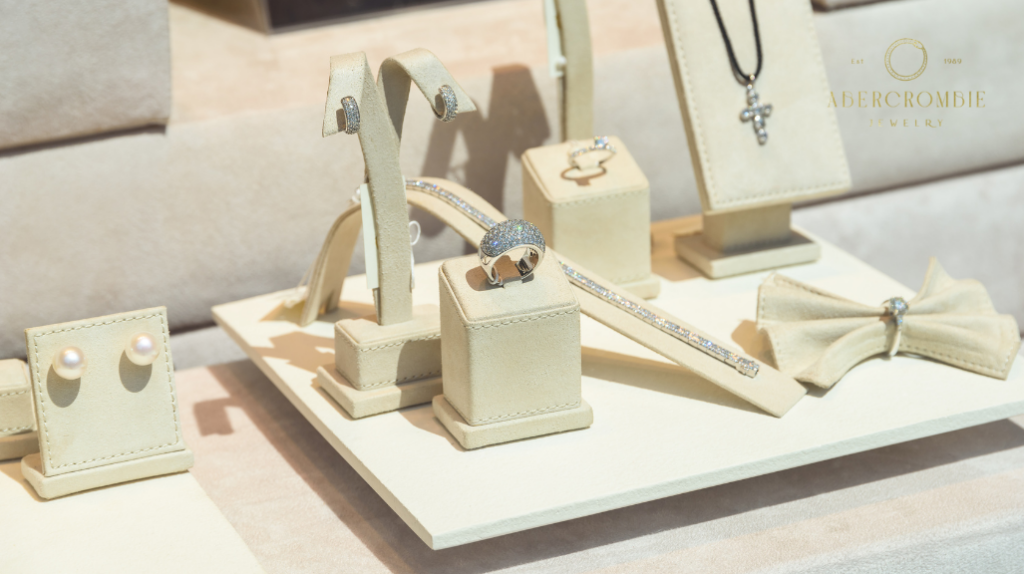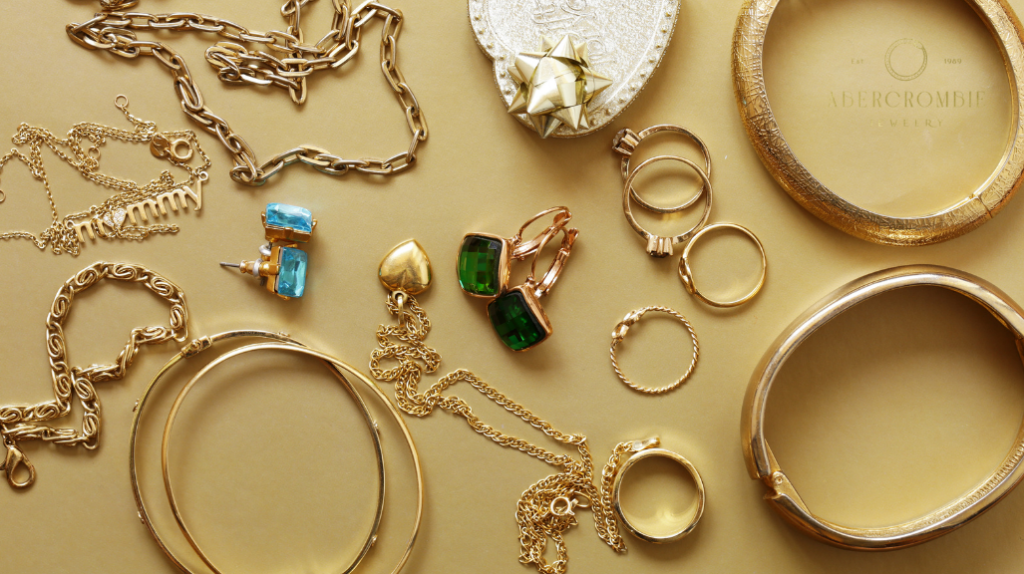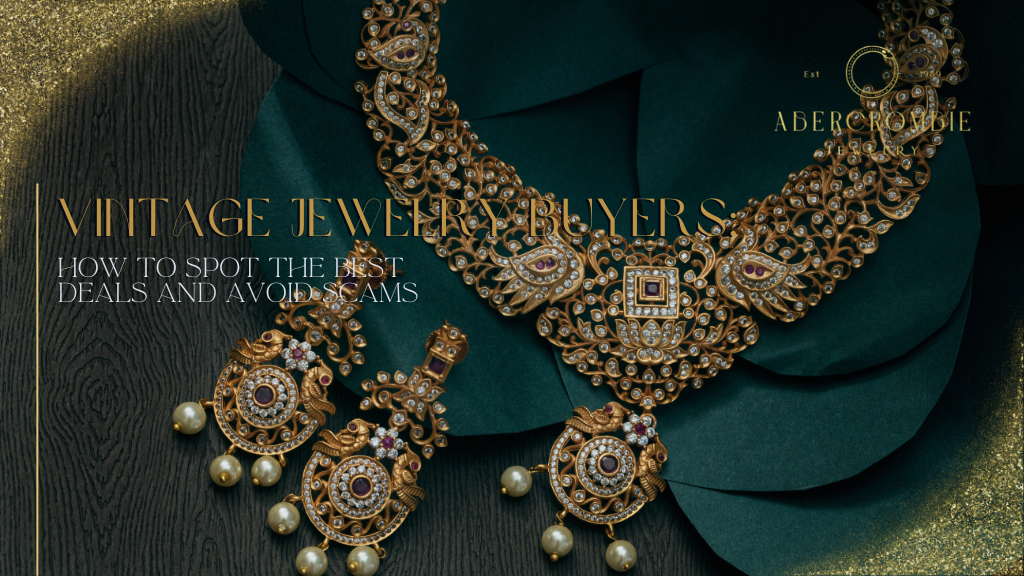Imagine walking into a room filled with sparkling, timeworn treasures, each piece whispering tales of a bygone era. As a vintage jewelry buyer, you’re not just hunting for beauty but also for authenticity and value. Learning how to verify hallmarks, assess craftsmanship, and navigate market trends is essential to avoid falling victim to scams. Misleading descriptions and suspiciously low prices are red flags you can’t afford to ignore. Engaging with reputable jewelry sellers and sharpening your negotiation skills will increase your chances of making wise investments and uncovering true gems. Want to know where to start? At Abercrombie Jewelry, we specialize in authentic vintage jewelry, helping you avoid the pitfalls of the market. With the right guidance, you’ll be well on your way to finding timeless treasures.
Key Takeaways
- Examine hallmarks and maker’s marks to verify the origin and authenticity of vintage jewelry.
- Research current market trends and historical price data to avoid overpaying for pieces.
- Inspect the craftsmanship and materials for quality indicators like hand-finished details and natural inclusions in gemstones.
- Request provenance and documentation, including appraisal reports and past sales receipts, to establish authenticity.
- Be wary of misleading descriptions and prices that seem too good to be true; always insist on high-resolution photos.
Understanding Vintage Jewelry
Understanding vintage jewelry is essential if you want to make informed purchases and avoid costly mistakes. When diving into the vintage jewelry market, knowledge of vintage trends and jewelry history is your best ally. How can you distinguish authentic vintage jewelry from various eras, like Art Deco’s geometric patterns or the intricate designs of the Victorian period? Each era has its distinctive features. For example, Edwardian jewelry is often known for its detailed filigree work and platinum settings, while mid-century pieces may feature bold, modernist designs. By understanding these nuances, you can more accurately determine a piece’s origin and approximate age. Trends in the vintage market can fluctuate, making some pieces more desirable than others. For example, certain gemstones, like sapphires and emeralds, can greatly increase a piece’s value depending on current market preferences. Being aware of these trends can help you spot undervalued treasures that others might overlook. Moreover, understanding the history behind these pieces not only enriches your knowledge but also connects you to a community of like-minded enthusiasts. You’ll find yourself better equipped to engage in informed discussions and make confident, savvy purchases.
Researching Market Trends

To make savvy investments in vintage jewelry, start by identifying popular styles that resonate in today’s market. Track and analyze price fluctuations to understand when certain pieces are likely to be more valuable. This insight helps you spot deals and avoid overpaying for items that might be temporarily inflated in price.
Read next: How Jewelry Buyers Determine the Worth of Vintage and Antique Pieces?
Identify Popular Styles
Spotting popular styles in vintage jewelry requires keen attention to current market trends and a thorough understanding of historical fashion cycles. To identify the best pieces, focus on high-demand styles like Art Deco, characterized by geometric patterns and bold statement pieces. Victorian Revival jewelry often features intricate floral motifs and evokes a sense of historical romanticism. Retro Modern, with its bold and often playful designs from the 1940s and 1950s, remains a favorite for its nostalgic appeal. Edwardian Elegance, known for its delicate lace-like filigree work and refined beauty, captures the essence of early 20th-century sophistication. Mid Century pieces, which often embrace minimalist designs and clean lines, cater to those who appreciate a sleek, understated aesthetic. Art Nouveau jewelry, rich with organic shapes and nature-inspired themes, holds a timeless allure for collectors. For a touch of global flair, look for pieces with ethnic influences, which often feature unique craftsmanship and materials. Bohemian styles, with their free-spirited and eclectic vibe, continue to captivate those who seek individuality. By familiarizing yourself with these popular styles, you’ll not only find the best deals but also connect with a community that shares your passion for vintage elegance.
Analyze Price Fluctuations
While recognizing popular styles is key, knowing how prices fluctuate can greatly impact your decision-making process as a vintage jewelry buyer. Staying ahead of price trends means you’re not just a buyer, but a savvy investor. Market demand considerably influences prices, and understanding these dynamics can help you spot the best deals before they skyrocket. First, track price trends over time. Look at historical data to identify patterns. Are certain pieces appreciating? For example, Art Deco jewelry often sees spikes in value due to its timeless appeal. Next, consider the broader economic context. Economic downturns might depress prices, offering buying opportunities, while booms could inflate costs. Also, pay attention to auction results and dealer inventories. High demand can deplete stocks, driving prices up. Conversely, an oversupply might mean bargains. Finally, join online forums and social media groups dedicated to vintage jewelry. These communities provide valuable insights into current market demand and price fluctuations. You’ll feel a sense of belonging while staying informed about the latest trends. Being well-versed in price trends and market demand guarantees that your purchases aren’t only beautiful but also wise investments. Knowledge is your best asset in steering through this ever-changing market.
Identifying Authentic Pieces

To identify authentic vintage jewelry, start by examining hallmarks and maker’s marks, which can reveal the piece’s origin and age. Assess the material and craftsmanship for quality indicators, such as precious metals and intricate designs.
Hallmarks and Maker’s Marks
Understanding hallmarks and maker’s marks is essential for anyone looking to identify authentic vintage jewelry. These tiny stamps or engravings on a piece validate its authenticity, age, and origin. Hallmarks often indicate the metal’s purity, while maker’s marks reveal the artisan or company behind the creation. Recognizing the hallmark importance can elevate your buying experience. A hallmark isn’t just a mark; it’s a story etched in metal, assuring you of the piece’s authenticity and quality. Maker’s marks carry the reputation of the jeweler. A renowned maker can greatly increase the piece’s value, making these marks a vital element to examine.
Here’s how you can leverage hallmarks and maker’s marks:
- Research Hallmarks: Familiarize yourself with common hallmarks from different periods and regions. This knowledge will help you verify the piece’s authenticity.
- Study Maker’s Marks: Learn about notable jewelry makers. Their marks can add considerable value due to their reputation.
- Use Reference Guides: Keep hallmark and maker’s mark reference guides handy. These can be invaluable when inspecting jewelry.
Material and Craftsmanship
Recognizing hallmarks and maker’s marks is just one piece of the puzzle when identifying authentic vintage jewelry. To truly understand an item’s worth, you need to explore its craftsmanship techniques and material types. Pay close attention to the intricacy of the design and the precision of the workmanship. Vintage pieces often feature hand-finished details that modern replicas can’t easily replicate. Look for indications of superior craftsmanship like clean soldering joints, well-set stones, and smooth finishes. Material types are equally important. Authentic vintage jewelry often uses high-quality metals and genuine gemstones. For example, platinum and 18k gold were commonly used in fine vintage pieces, while costume jewelry might feature brass or plated metals. Genuine gemstones will display natural inclusions and varying hues, unlike the uniform appearance of synthetic stones. Understanding these elements helps you differentiate between genuine vintage items and modern imitations. By mastering the nuances of craftsmanship techniques and material types, you’re not just buying jewelry; you’re joining a community of informed collectors who value authenticity and historical significance. This knowledge enables you to spot the best deals and avoid scams, making you a savvy and respected vintage jewelry buyer.
Provenance and Documentation
Provenance plays an essential role in identifying authentic vintage jewelry. You can’t underestimate the provenance significance when discerning genuine pieces from cleverly crafted replicas. Provenance, or the history of ownership, adds immense value and authenticity to your collection. To guarantee you’re making a sound investment, investigate the documentation sources available.
Here’s how to get started:
- Examine Certificates of Authenticity: These documents often accompany high-value pieces and provide a clear lineage, confirming the piece is indeed vintage.
- Review Appraisal Reports: Professional appraisals offer detailed insights into the jewelry’s origin, materials, and craftsmanship, further validating its authenticity.
- Check Provenance Records: These may include past sales receipts, auction records, or even historical references that trace the jewelry’s journey through time.
Always request these documentation sources from sellers or dealers. A reputable dealer will happily provide them, understanding their importance in establishing the provenance significance.
Recognizing Common Scams

Maneuvering the vintage jewelry market can be a treasure hunt, but it’s also fraught with pitfalls. Scammers often prey on unsuspecting buyers, so you must equip yourself with knowledge to spot scam tactics and avoid costly mistakes. One common scam involves counterfeit detection. Recognizing a fake piece can be tricky, but there are telltale signs. Look closely at hallmarks and stamps; genuine vintage pieces often have specific marks indicating metal purity and origin. Scammers might use acid tests to fake these, so be cautious. Another tactic involves misleading descriptions. Sellers may use terms like “vintage-inspired” or “antique-style” to sell modern replicas. Always ask for detailed provenance to verify a piece’s history. Additionally, beware of too-good-to-be-true prices. If a deal feels off, it probably is. Research current market values and compare similar items to verify you’re not being duped. Stay vigilant in online transactions. Insist on high-resolution photos and, if possible, third-party authentication. Trust your instincts and don’t rush into purchases; scammers thrive on hurried decisions.
Evaluating Condition and Quality
Evaluating the condition and quality of vintage jewelry is essential to making wise investments. You’ll need to be meticulous, as even the smallest flaw can greatly impact a piece’s worth. Start by examining the jewelry under a loupe or magnifying glass. Pay attention to the craftsmanship, any signs of wear, and potential restoration techniques used.
Key Steps to Evaluate Condition and Quality:
- Inspect Metal and Stones: Look for hallmarks and stamps indicating metal purity. Check stones for chips, cracks, and secure settings.
- Assess Craftsmanship: High-quality vintage jewelry often showcases superior craftsmanship. Look for intricate designs, precise settings, and a well-finished back.
- Understand Grading Systems: Familiarize yourself with grading systems for both metals and gemstones. These systems help standardize quality and can guide you in making informed decisions.
Being part of the vintage jewelry community means valuing authenticity and quality. Restoration techniques can sometimes enhance a piece but may also mask flaws. Always ask for a detailed history and any documentation available. Whether you’re a seasoned collector or new enthusiast, mastering these evaluation skills will help you spot the best deals and avoid scams.
Assessing Value and Pricing

When you’re diving into the vintage jewelry market, understanding how to assess value and pricing is vital for making smart purchases. First, familiarize yourself with key appraisal techniques. Start by examining the craftsmanship, as well-made pieces typically indicate higher value. Use a jeweler’s loupe to inspect hallmarks and signatures; these can authenticate the piece and provide insights into its origin and age. Next, consider the materials used. Precious metals like gold and platinum, along with gemstones such as diamonds, sapphires, and emeralds, greatly impact value. Compare these elements against current market prices to get a baseline figure. Don’t forget to assess the rarity and historical significance, as these aspects can add considerable value. Now, let’s talk pricing strategies. Knowledge of market trends is vital. Monitor auction results and consult price guides to understand current valuations. Keep an eye on the condition, provenance, and demand for similar items. Sellers often mark up prices, so it’s wise to compare multiple sources before committing.
Negotiation Strategies
While traversing the vintage jewelry market, mastering negotiation strategies can considerably enhance your buying experience. Employing effective bargaining techniques not only guarantees you get the best price but also helps in building rapport with sellers.
Here’s how you can elevate your negotiation game:
- Do Your Homework: Before engaging in any bargaining, research the piece you’re interested in. Understand its historical value, typical market price, and any unique features it might have. This knowledge empowers you to make informed counteroffer tactics.
- Start Low, But Fair: When you initiate an offer, start lower than what you’re willing to pay, but make sure it’s within a reasonable range to avoid insulting the seller. This leaves room for negotiation and shows that you’re serious yet savvy.
- Leverage Silence and Body Language: Sometimes, the most powerful bargaining techniques involve less talking. After making your offer, stay silent and let the seller ponder.
Your body language should exude confidence and patience, indicating you’re in control of the negotiation process.
Trusted Sellers and Platforms
Maneuvering the vintage jewelry market requires a keen eye for trusted sellers and reliable platforms to guarantee authenticity and fair pricing. Start by exploring reputable online marketplaces like Etsy and eBay, where seller reviews and ratings offer insightful feedback. Look for sellers with extensive positive reviews and detailed descriptions of their items. Vintage fairs are a fantastic place to find reliable vendors, especially when searching for unique pieces. At these events, you can explore multiple sellers in one spot, allowing you to examine items closely and ask questions in person. Building relationships with sellers at vintage fairs can offer you insider knowledge and early access to new pieces. For more helpful advice, check out Tips for Buying Vintage and Antique Jewelry to make the most of your search.
Here’s a quick reference table to guide you:
| Platform | Pros | Cons |
| Etsy | Wide selection, seller reviews | Variable pricing |
| eBay | Auction options, extensive ratings | Risk of counterfeit items |
| Ruby Lane | Curated collections, high quality | Higher price points |
| Local Vintage Fairs | Direct interaction, inspect items | Limited to event dates |
| 1stdibs | Premier items, trusted sellers | Premium prices |
Safeguarding Your Investment

Protecting your investment in vintage jewelry demands meticulous attention to detail and a strategic approach. It’s not just about scoring a beautiful piece; it’s about guaranteeing its long-term value and safeguarding it against potential risks. Here are some essential strategies to enhance your investment protection and risk management:
- Authenticate Your Pieces: Verify authenticity by consulting reputable appraisers or using trusted certification services. Genuine vintage pieces should come with provenance or documentation that confirms their history and value.
- Proper Storage and Care: Store your jewelry in a secure, climate-controlled environment to prevent damage. Use individual pouches or padded boxes to avoid scratches and consider investing in a safe or deposit box for high-value items.
- Insurance Coverage: Obtain extensive insurance for your vintage jewelry. Confirm your policy covers theft, loss, and damage. Regularly update appraisals to reflect current market values and adjust your coverage accordingly.
Frequently Asked Questions
Conclusion
Picture yourself holding a glistening vintage brooch, its intricate design telling stories of bygone eras. You’ve navigated market trends, verified hallmarks, and scrutinized craftsmanship. By engaging with trusted sellers and platforms, and utilizing sharp negotiation strategies, you’ve safeguarded your investment against scams. The thrill of finding authentic vintage pieces at the best prices is unmatched. With your newfound knowledge, you’re now poised to uncover more hidden gems in the world of vintage jewelry.

